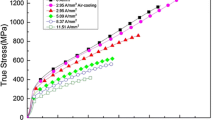Abstract
Difficulties of processing of high strength and/or brittle materials by plastic deformation, e.g., by forging, require to develop new industrial technologies. In particular, the feasible deformation rates are limited for low-ductile metallic materials. For this reason, processes were investigated to improve the deformability in which electrical impulses are to be applied to lower the yield strength. However, owing to the impulse duration and low current densities, concomitant effects always occur, e.g., as a result of Joule heating. Current developments in power electronics allow now to transmit high currents as short pulses. By reducing the impulse duration and increasing the current density, the plasticity of metallic materials can be correspondingly increased. Using the examples of polycrystalline iron and a single-crystal, nickel-based alloy (PWA 1480), current advances in the development of methods for forming materials by means of high-current-density impulses are demonstrated. For this purpose, appropriate specimens were loaded in compression and, using novel testing equipment, subjected to a current strength of 10 kA with an impulse duration of 2 ms. For a pre-defined strain, the test results show a significant decrease in the compressive stress during the compression test and a significant change in the dislocation distribution following the current impulse treatment.











Similar content being viewed by others
References
V.E. Gromov, L.B. Zuev, E.V. Kozlov, and V.J. Tsellermeyer, Electrostimulated Plasticity of Metals and Alloys, Nedra, Moscow, 1996 (in Russian)
W.I. Spizyn and O.A. Troitskiy, Electroplastic Deformation of Metal, Nauka, Moscow, 1985 (in Russian)
A.F. Sprecher, S.L. Mannan, and H. Conrad, On the Mechanisms for the Electroplastic Effect in Metals, Acta Metall., 1986, 34(7), p 1145–1162
F.-W. Bach, L. Walden, B. Svendsen, J. Unger, H. Blum, and M. Stiemer, On the Effect of Current Pulses on the Material Behaviour During Electromagnetic Metal Forming, Proceedings of the Second International Conference on High Speed Forming, Germany (Dortmund), 2006, p 107–109
K. Okazaki, M. Kagawa, and H. Conrad, Effects of Strain Rate, Temperature and Interstitial Content on the Electroplastic Effect in Titanium, Scr. Metall., 1979, 13, p 473–477
G. Gerstein, M. Nowak, M. Bierbaum, T. Zhuravina, M. Schaper, and F.-W. Bach, Increase the Deformability of NiCo Single Crystals Using of Electrical Pulse-Like Currents, Key Eng. Mater., 2012, 504–506, p 143–148
K.M. Klimov and I.I. Novikov, Features of Plastic Deformation of Metals in an Electromagnetic Field, Sov. Phys. Dokl., 1980, 25(7), p 571–573
O.A. Troitskiy and V.I. Likhtman, Anisotropy of the Effect of Electron and γ-Irradiation on the Process of Deformation of Zinc Single Crystals in the Brittle State, Dokl Akademiya Nauk SSSR, 1963, 148(2), p 332–334 (in Russian)
M.I. Molotskii and V. Fleurov, Magnetic Effects in Electroplasticity of Metals, Phys. Rev. B, 1995, 52(22), p 829–834
K.M. Klimov and I.I. Novikov, The Electroplastic Effect, Strength of Mater., 1984, 16, p 270–276
O.A. Troitskii and V.I. Spitsyn, Investigation of the Electroplastic Deformation of a Metal by the Method of Stress Relaxation and Creep, Sov. Phys. Dokl., 1976, 21(2), p 111–113
V.B. Fiks, Interaction of Conduction Electrons with Single Dislocations in Metals, JEPT, 1981, 53(6), p 1209–1211
A.F. Sprecher, S.L. Mannan, and H. Conrad, On the Temperature Rise Associated with the Electroplastic Effect in Titanium, Scr. Metall., 1983, 17(6), p 769–772
K. Küpfmüller, W. Mathis, and A. Reibiger, Theoretical Electrical Engineering, Springer, Berlin, 2008 (in German)
T.M. Pallock and S. Tin, Nickel-Based Superalloys for Advanced Turbine Engines: Chemistry, Microstructure, and Properties, J. Propuls. Power, 2006, 22(2), p 361–374
N.A. Koneva, Classification, Evolution and Self-Organization Structures in Metals and Alloys, Soros Educ J, 1996, 6, p 99–107 (in Russian)
A.I. Epishin, T. Link, and U. Brückner, Residual Stresses in the Dendritic Structure of Single-Crystal Nickel-Based Superalloy, Phys. Met. Metall., 2005, 100(2), p 192–199
W. Hermann, H.G. Sockel, J. Han, and A. Bertram, Elastic Properties and Determination of Elastic Constants of Nickel-Base Superalloy by a Free-Free Beam Technique, Superalloys, 1996, p 229–238
P. Hautojärvi, A. Vehanen, and V.S. Mikhalenkov, Recovery of Deformed Iron Studied by Positrons, Appl. Phys., 1976, 11, p 191–192
H. Conrad and W. Hayes, Correlation of the Thermal Component of the Yield Stress of Body Centered Cubic Metals, Aerospace Corporation, El Segundo, CA, 1963
T. Link, A. Epishin, M. Paulisch, and T. May, Topography of Semicoherent γ/γ’-interfaces in Superalloys: Investigation of the Formation Mechanism, Mater. Sci. Eng. A, 2011, 528, p 6225–6234
M.G. Hebsur, and R.V. Miner, Elevated temperature tension, compression, and creep-rupture behavior of [001]-oriented single-crystal superalloy PWA 1480, NASA Technical Memorandum 88950, 1987
V. Levitin, High Temperature Strain of Metals and Alloys: Physical Fundamentals, Wiley-VCH Verlag GmbH & Co. KGaA, Weinheim, 2006
Acknowledgment
Financial support for this work provided by the German Science Foundation (DFG) under Contract GE 2673/2-1.
Author information
Authors and Affiliations
Corresponding author
Rights and permissions
About this article
Cite this article
Demler, E., Gerstein, G., Dalinger, A. et al. Influence of High-Current-Density Impulses on the Compression Behavior: Experiments with Iron and a Nickel-Based Alloy. J. of Materi Eng and Perform 26, 177–184 (2017). https://doi.org/10.1007/s11665-016-2457-x
Received:
Revised:
Published:
Issue Date:
DOI: https://doi.org/10.1007/s11665-016-2457-x




